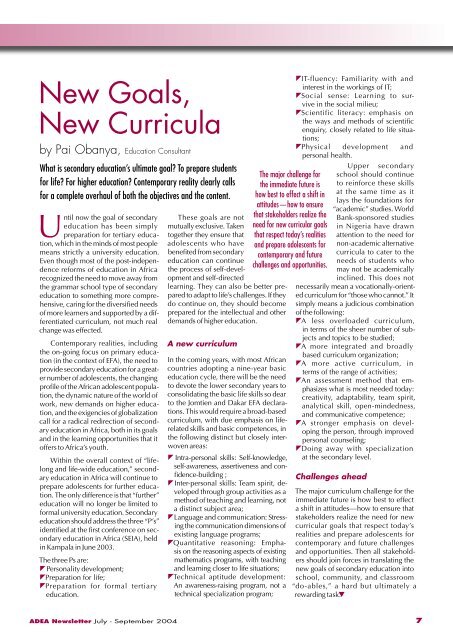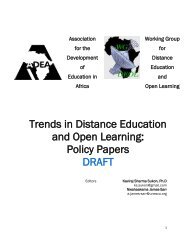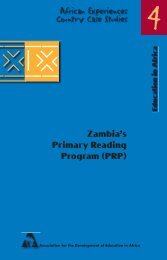Newsletter Vol.16 No.3 - ADEA
Newsletter Vol.16 No.3 - ADEA
Newsletter Vol.16 No.3 - ADEA
You also want an ePaper? Increase the reach of your titles
YUMPU automatically turns print PDFs into web optimized ePapers that Google loves.
New Goals,New Curriculaby Pai Obanya, Education ConsultantWhat is secondary education’s ultimate goal? To prepare studentsfor life? For higher education? Contemporary reality clearly callsfor a complete overhaul of both the objectives and the content.Until now the goal of secondaryeducation has been simplypreparation for tertiary education,which in the minds of most peoplemeans strictly a university education.Even though most of the post-independencereforms of education in Africarecognized the need to move away fromthe grammar school type of secondaryeducation to something more comprehensive,caring for the diversified needsof more learners and supported by a differentiatedcurriculum, not much realchange was effected.Contemporary realities, includingthe on-going focus on primary education(in the context of EFA), the need toprovide secondary education for a greaternumber of adolescents, the changingprofile of the African adolescent population,the dynamic nature of the world ofwork, new demands on higher education,and the exigencies of globalizationcall for a radical redirection of secondaryeducation in Africa, both in its goalsand in the learning opportunities that itoffers to Africa’s youth.Within the overall context of “lifelongand life-wide education,” secondaryeducation in Africa will continue toprepare adolescents for further education.The only difference is that “further”education will no longer be limited toformal university education. Secondaryeducation should address the three “P’s”identified at the first conference on secondaryeducation in Africa (SEIA), heldin Kampala in June 2003.The three Ps are:Personality development; Preparation for life; Preparation for formal tertiaryeducation.These goals are notmutually exclusive. Takentogether they ensure thatadolescents who havebenefited from secondaryeducation can continuethe process of self-developmentand self-directedlearning. They can also be better preparedto adapt to life’s challenges. If theydo continue on, they should becomeprepared for the intellectual and otherdemands of higher education.A new curriculumIn the coming years, with most Africancountries adopting a nine-year basiceducation cycle, there will be the needto devote the lower secondary years toconsolidating the basic life skills so dearto the Jomtien and Dakar EFA declarations.This would require a broad-basedcurriculum, with due emphasis on liferelatedskills and basic competences, inthe following distinct but closely interwovenareas: Intra-personal skills: Self- knowledge,self-awareness, assertiveness and confidence-building;Inter-personal skills: Team spirit, developedthrough group activities as amethod of teaching and learning, nota distinct subject area;Language and communication: Stressingthe communication dimensions ofexisting language programs; Quantitative reasoning: Emphasison the reasoning aspects of existingmathematics programs, with teachingand learning closer to life situations; Technical aptitude development:An awareness-raising program, not atechnical specialization program;The major challenge forthe immediate future ishow best to effect a shift inattitudes—how to ensurethat stakeholders realize theneed for new curricular goalsthat respect today’s realitiesand prepare adolescents forcontemporary and futurechallenges and opportunities. IT-fluency: Familiarity with andinterest in the workings of IT; Social sense: Learning to survivein the social milieu; Scientific literacy: emphasis onthe ways and methods of scientificenquiry, closely related to life situations; Physical development andpersonal health.Upper secondaryschool should continueto reinforce these skillsat the same time as itlays the foundations for“academic” studies. WorldBank-sponsored studiesin Nigeria have drawnattention to the need fornon-academic alternativecurricula to cater to theneeds of students whomay not be academicallyinclined. This does notnecessarily mean a vocationally-orientedcurriculum for “those who cannot.” Itsimply means a judicious combinationof the following: A less overloaded curriculum,in terms of the sheer number of subjectsand topics to be studied; A more integrated and broadlybased curriculum organization; A more active curriculum, interms of the range of activities; An assessment method that emphasizeswhat is most needed today:creativity, adaptability, team spirit,analytical skill, open-mindedness,and communicative competence; A stronger emphasis on developingthe person, through improvedpersonal counseling; Doing away with specializationat the secondary level.Challenges aheadThe major curriculum challenge for theimmediate future is how best to effecta shift in attitudes—how to ensure thatstakeholders realize the need for newcurricular goals that respect today’srealities and prepare adolescents forcontemporary and future challengesand opportunities. Then all stakeholdersshould join forces in translating thenew goals of secondary education intoschool, community, and classroom“ do-ables,” a hard but ultimately arewarding task.▼<strong>ADEA</strong> <strong>Newsletter</strong> July - September 20047
















